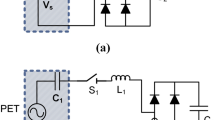Abstract
A controllable power conditioning circuit is proposed for battery-free energy harvesting applications. The circuit is designed for piezoelectric energy harvester applications and it has only 11 transistors and consist a simple feedback loop and switched capacitor that conditionally allows the power to be applied to the load (circuit to be powered in this case). The area- and power-efficient digital design that does not include any inductors makes the topology easy to apply to any low-power sensor applications. The power conditioning circuit relies on a digital Schmitt trigger that controls the voltage threshold values of the power supply where the load circuit would operate within. The hysteresis (hence the threshold) levels were set to 435 and 710 mV and the overall energy conversion efficiency is around 65 %. The theory of the piezoelectric harvester was also studied.





Similar content being viewed by others
References
Priya, S., & Inman, D. (2009). Energy harvesting technologies. New York: Springer.
Le, T. T., Han, J., von Jouanne, A., Mayaram, K., & Fiez, T. S. (2006). Piezoelectric micro-power generation interface circuits. IEEE Journal of Solid-State Circuits, 41(6), 1411–1420.
Dicken, J., Mitcheson, P. D., Stoianov, I., & Yeatman, E. M. (2012). Power-extraction circuits for piezoelectric energy harvesters in miniature and low-power applications. IEEE Transactions on Power Electronics, 27(11), 4514–4529.
Kaya, T., Koser, H., & Culurciello, E. (2006). A low-voltage temperature sensor for micro power harvesters in silicon-on-sapphire CMOS. Electronics Letters, 42, 526–528.
Paradiso, J. A., & Starner, T. (2005). Energy scavenging for mobile and wireless electronics. IEEE Pervasive Computing, 4(1), 18–27.
Ottman, G. K., Hofmann, H. F., & Lesieutre, G. A. (2003). Optimized piezoelectric energy harvesting circuit using step-down converter in discontinuous conduction mode. IEEE Transactions on Power Electronics, 18(2), 696–703.
D’hulst, R., Sterken, T., Puers, R., Deconinck, G., & Driesen, J. (2010). Power processing circuits for piezoelectric vibration-based energy harvesters. IEEE Transactions on Industrial Electronics, 57(12), 4170–4177.
Kong, N. A., Ha, D. S., Erturk, A., & Inman, D. J. (2010). Resistive impedance matching circuit for piezoelectric energy harvesting. Journal of Intelligent Material Systems and Structures, 21, 1293–1302.
Han, J. (2004). Novel power conditioning circuits for piezoelectric micro power generators. In Applied Power Electronics Conference and Exposition, 2004.
Kaya, T., & Koser, H. (2005, October). A study of nonlinear deflection dynamics of a piezoelectric accelerometer. FEMLAB Conference, Boston, MA.
Piezo generator/sensor kit manual. Retrieved December 4, 2014 from http://piezo.com.
Author information
Authors and Affiliations
Corresponding author
Rights and permissions
About this article
Cite this article
Liu, G., Fuentes, R., Koser, H. et al. A self-powered power conditioning circuit for battery-free energy scavenging applications. Analog Integr Circ Sig Process 83, 203–207 (2015). https://doi.org/10.1007/s10470-015-0530-2
Received:
Accepted:
Published:
Issue Date:
DOI: https://doi.org/10.1007/s10470-015-0530-2




